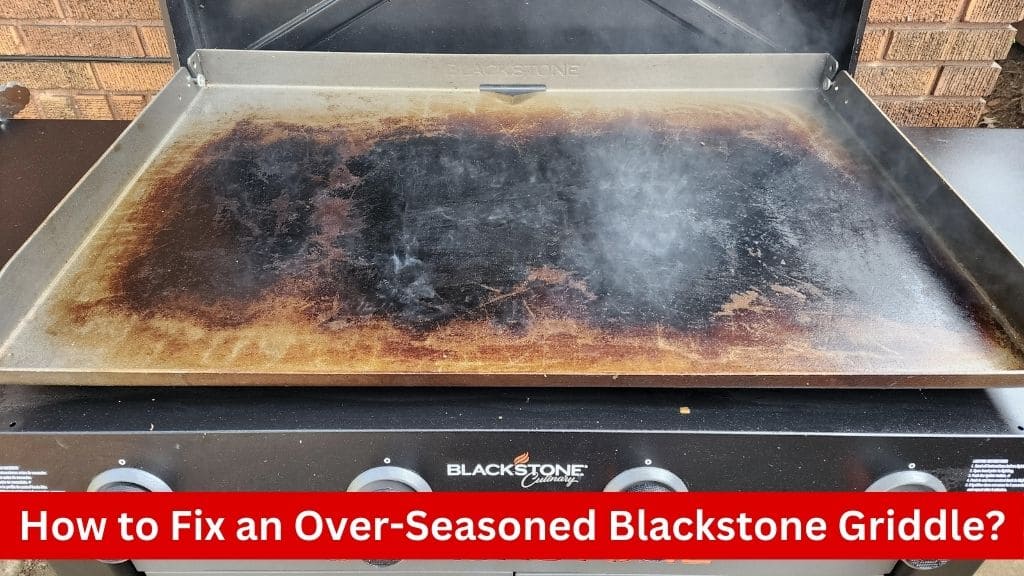Has your beloved Blackstone griddle fallen victim to over-seasoning? Don’t panic! While the thought of having an over-seasoned griddle may seem daunting, it’s a common issue that can be remedied with the right techniques. In this comprehensive guide, we’ll walk you through the steps to fix an over-seasoned Blackstone griddle, restoring it to its former glory.
Before diving into the solutions, let’s understand what over-seasoning actually means. Over-seasoning occurs when multiple layers of oil build up on the griddle surface, resulting in a sticky or gummy residue. This buildup can affect the cooking performance of your griddle, leading to uneven heat distribution and food sticking to the surface.
Signs of Over-Seasoning

- Sticky or Tacky Residue: When your griddle is over-seasoned, you may notice that the cooking surface feels sticky or tacky to the touch. This stickiness is caused by the buildup of polymerized oil, which can make it difficult to cook food evenly and may result in a less-than-ideal cooking experience.
- Uneven Heat Distribution: Over-seasoning can also affect the heat distribution on your griddle. The excess oil buildup can create hot spots and cold spots on the cooking surface, leading to uneven cooking. You may find that some areas of the griddle cook food too quickly, while others cook it too slowly, resulting in inconsistent results.
- Difficulty in Cleaning: Cleaning an over-seasoned griddle can be challenging, as the sticky residue tends to cling stubbornly to the cooking surface. Even with scrubbing and cleaning efforts, you may find that the residue persists, making it hard to achieve a clean and pristine surface for cooking.
- Food Sticking to the Surface: Despite applying oil to prevent sticking, you may find that food still sticks to the griddle surface when it’s over-seasoned. This can be frustrating, as it defeats the purpose of using a griddle for easy and non-stick cooking. Over-seasoning creates a gummy layer on the griddle, causing food to adhere to it rather than sliding off easily.
Steps to Fix an Over-Seasoned Blackstone Griddle

Step 1: Scrubbing
- Heat the Griddle: Before scrubbing, it’s essential to heat the griddle. Turning on the griddle and allowing it to heat up helps to soften and loosen the excess oil buildup, making it easier to remove. The heat also helps to break down any stubborn residues that may be stuck to the surface.
- Scrub with a Grill Brush: Once the griddle is heated, use a grill brush or a scrubbing pad to vigorously scrub the surface. Focus on areas where there’s heavy buildup of oil or sticky residue. The bristles of the grill brush or the abrasive surface of the scrubbing pad help to dislodge the oil and dirt, allowing them to be wiped away more easily.
- Use Vinegar Solution (Optional): If the oil buildup is particularly stubborn, you can create a vinegar solution by mixing equal parts water and white vinegar. Apply this solution to the griddle surface and scrub again. The acidity of the vinegar helps to break down the oil residue, making it easier to remove.
Step 2: Seasoning Reset
- Heat the Griddle: Start by turning on the griddle and allowing it to heat up. Heating the griddle helps to open up the pores of the metal surface, allowing the oil to penetrate and bond with the metal effectively. It also ensures that the griddle is thoroughly heated, which is essential for the oil to polymerize and form a durable seasoning layer.
- Apply Thin Layer of Oil: Once the griddle is hot, apply a thin layer of high smoke point oil to the cooking surface. High smoke point oils such as flaxseed oil, vegetable oil, or grapeseed oil are recommended for seasoning as they can withstand high temperatures without burning or becoming sticky. Use a cloth or paper towel to spread the oil evenly across the entire surface of the griddle.
- Heat Until Smoking: Allow the griddle to heat until the oil starts to smoke. This indicates that the oil is polymerizing and adhering to the griddle surface, forming a new seasoning layer. Heating the oil also helps to eliminate any excess moisture from the surface, ensuring a more durable and effective seasoning.
- Cool Down: Once the oil has smoked, turn off the griddle and allow it to cool down completely. Cooling down the griddle allows the oil to set and solidify, creating a smooth and non-stick surface for cooking. It’s essential to let the griddle cool down naturally to prevent any damage to the seasoning layer.
- Repeat Seasoning Process: For optimal results, repeat the seasoning process two to three times, applying a thin layer of oil and heating until smoking each time. This helps to build up multiple layers of seasoning, resulting in a more durable and effective non-stick surface. Make sure to let the griddle cool down completely between each seasoning cycle to allow the oil to set properly.
Step 3: Seasoning Maintenance
- Use High Smoke Point Oils: When seasoning or re-seasoning your griddle, it’s essential to use oils with high smoke points. These oils, such as flaxseed oil, vegetable oil, or grapeseed oil, can withstand high temperatures without burning or becoming sticky. Using high smoke point oils helps to create a durable seasoning layer that effectively prevents food from sticking to the griddle surface.
- Avoid Excessive Oil: When oiling your griddle, always apply a thin, even layer of oil. Avoiding excessive oil prevents the buildup of excess oil on the griddle surface, which can lead to over-seasoning and sticky residues. Using too much oil can also cause the seasoning layer to become uneven and less effective.
- Regular Cleaning: Cleaning your griddle regularly is essential for maintaining its seasoning layer. After each use, remove any food residue and debris from the griddle surface using a grill brush or scraper. Cleaning the griddle helps to prevent the buildup of oil and food particles, which can lead to over-seasoning and sticky residues over time.
- Seasoning Touch-Ups: If you notice uneven seasoning or areas with excessive oil buildup on your griddle, you can perform seasoning touch-ups as needed. Simply heat the griddle, apply a thin layer of oil, and heat until smoking. This helps to refresh the seasoning layer and ensure that it remains effective in preventing food from sticking to the surface.
Conclusion
Fixing an over-seasoned Blackstone griddle may seem like a daunting task, but with the right techniques, it can be easily remedied. By following the steps outlined in this guide, you can restore your griddle to its optimal condition and enjoy hassle-free cooking once again. Remember to maintain regular seasoning and cleaning practices to prevent over-seasoning in the future. Happy griddling!



